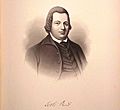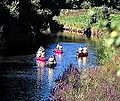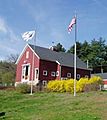History of Uxbridge, Massachusetts facts for kids
The town of Uxbridge, Massachusetts was founded in 1727. Its story includes ancient times, colonial days, and its important role in America's factories. Uxbridge is right on the border of Massachusetts and Rhode Island. It became a key spot for the very first factories in the United States.
Contents
Uxbridge: A Town of Firsts and Factories
Uxbridge was one of the earliest places where the American Industrial Revolution began. Factories grew here because of its location, lots of water power, and the Blackstone Canal. Smart inventors helped shape America's textile industry.
The town shows us what early America was like. It was once Nipmuc land, saw King Phillips War, and lived under colonial rule. Important events like the Great Awakening and the American Revolution also happened here. Quakers, who believed in peace and equality, also had a big impact.
Uxbridge is in the middle of the Blackstone River Valley National Heritage Corridor. This area was the first to have many factories in the U.S. There are over 375 historic places here, showing many different building styles. Military uniforms were made in large mills here for more than 100 years. The very first U.S. Air Force uniform, called "Uxbridge Blue," was made in this town.
Uxbridge also has a special place in women's history. Lydia Chapin Taft was America's first woman to vote legally in colonial times. The town was named after the Earl of Uxbridge in England. The Taft family settled nearby in 1680. They were founders of Uxbridge. Robert Taft, II, was on the first town council.
This town played early roles in public education and human rights. It was also important for women's suffrage (women's right to vote) and public health. In the 1700s, Uxbridge started public education early, by 1731. By 1797, it had 13 district schools.
Uxbridge was home to six notable women:
- Lydia Chapin Taft, America's first legal colonial woman voter.
- Deborah Sampson, America's first woman soldier.
- Abby Kelley Foster, a social reformer in the 1800s.
- Alice Bridges, an Olympic medalist in 1936.
- Jeannine Oppewall, a Hollywood film producer.
- Jacqueline Liebergott, the first female president of Emerson College.
In 1922, Uxbridge appointed the first women jurors in Massachusetts. This happened just two years after women gained the right to vote across the country. Effingham Capron led the first power looms for wool in his mills. He was also a strong leader in anti-slavery groups. He helped people escape slavery on the Underground Railroad.
Early History of Uxbridge
Ancient Times: The Nipmuc People
Long ago, before Europeans arrived, Native American people lived in this part of Massachusetts. Arrowheads and other old tools have been found near the local rivers. The Nipmuc people, whose name means "small pond people," settled here. They lived at places called Wacentug and Shock-a-log. Wacentug means "tribe that fished rich waters."
The village of Wacentug was between the Nipmuc River (now the Blackstone River) and the West River. The Nipmuc River had many fish like salmon. Wacentug had about 50 people in the mid-1600s. The Nipmuc were an Algonquian tribe. They were skilled farmers, growing corn, beans, and squash. They also had a graphite mine and a written language. The tribe moved with the seasons, fishing and farming in the gentle hills and streams of southern New England. Nipmuc people still live in the Worcester County area today.
Colonial Era: European Settlement
Puritan missionary John Eliot helped start "Praying Indian" villages like Wacentug. European settlers began to arrive in the 1640s. In 1659, the Massachusetts Bay Colony allowed pioneers to buy land from the Nipmuc. In 1662, settlers from Braintree and Weymouth bought land from the Nipmuc chief "Great John." This land became Mendon in 1667.
The settlement was burned during King Philip's War in 1675. Some of the first Massachusetts colonists were killed. After the war ended, people resettled in 1680. More families moved west and settled near Wacentug. Farmers grew crops on the rich land between the three rivers. The Taft family and the Aldriches settled here around 1680.
The town of Uxbridge was officially created in June 1727. The Farnum House held the first town meeting. One of the first things the town did was to get "fifteen gallons of rum" for building the meeting house. The colonial town was mostly a farming area. It had some grist mills (for grinding grain), distilleries (for making drinks), and iron works. The town was named after the Earl of Uxbridge in England.
The first town leaders included Robert Taft, 2nd, and Ebeneazer Read. The town also included the area that is now Northbridge.
Reverend Nathan Webb's church was the first in Uxbridge. It was the first new Congregational church in Massachusetts during the First Great Awakening. Members of Webb's church helped make history. These included Josiah and Lydia Taft, Captain Bezaleel Taft, Sr., and Seth Reed.
Uxbridge settlers fought in the French and Indian Wars. Captain Josiah Taft's widow, Lydia Chapin Taft, voted to fund this war in 1756. This was a very early step for women's suffrage. The town meeting minutes show her voting again in 1758 and 1765. She lived to see her son, Captain Bezaleel Taft, Sr., fight in the American War for Independence. Lydia Chapin Taft died in 1778. A judge later wrote that by letting "widow Taft" vote, the town followed the idea of "no taxation without representation." Lydia's historic vote happened 164 years before women could vote across America in 1920.
The town's future as a factory center was set. It had good iron ore and plenty of renewable energy from the Mumford, West, and Blackstone rivers.
Quakers in Uxbridge
Quakers from Smithfield, RI came to Uxbridge. They built mills, railroads, houses, and tools. They also made Conestoga wagon wheels. The Uxbridge Friends Meetinghouse was built from bricks made on Moses Farnum's farm. Famous abolitionists like Abby Kelley Foster and Effingham Capron were members here. The local anti-slavery society had 450 members, which was a quarter of the town's population.
Quaker abolitionists, who were against slavery, settled here around 1769. Among them was Richard Mowry, an inventor important to the Industrial Revolution. The "Quaker City" settlement changed the town. The Quakers built mills and homes. Southwick's store had Uxbridge's "Social and Instructive Library," started in 1775.
The Friends Meetinghouse was a place where "fiery abolitionist" Abby Kelley Foster spoke. She became a national leader in the anti-slavery movement. The "Uxbridge monthly meeting" later disagreed with Kelley's "radical views." Historic Quaker homes were part of the Underground Railroad. This was a secret network that helped enslaved people escape to freedom. Effingham Capron became a national leader in anti-slavery groups.
The important American Aldrich family started here. The village of Aldrich was next to the Friend's Meeting House. Quaker families like Elisha Southwick made Conestoga wagon wheels. They also made Kentucky Blue Jeans in the 1800s.
Farming was important in Quaker City and south Uxbridge. The land was fertile, with rivers and cranberry bogs. Benedict Arnold's widow, Peggy Shippen, a Quaker, lived in Uxbridge before she died in 1836.
Revolutionary War Era
Heavy British taxes after the French and Indian War led to the American Revolution. Two brothers, Seth and Joseph Read, joined local groups that shared information about British actions. Colonel John Spring led a Massachusetts Militia company of Uxbridge men. They prepared for battle. Many local men fought at the Lexington Alarm and at Bunker Hill.
General George Washington stopped at a tavern owned by Colonel Seth Read in June 1775. This was before he took command of the Continental Army in Boston. Many Uxbridge soldiers served in the Revolution. Baxter Hall, an 18-year-old drummer, served at Bunker Hill. Samuel Spring, an Uxbridge native, became a Revolutionary War chaplain. He served under Colonel Benedict Arnold.
Deborah Sampson, America's first woman soldier, joined the Continental Army. She pretended to be a teenage boy named "Robert Shurtlieff of Uxbridge." She was wounded in battle. General George Washington gave her an honorable discharge. Deborah later became a hero for women's rights.
Shays' Rebellion, an uprising of farmers, started in Uxbridge on February 3, 1783. Governor John Hancock stopped the local riots. Dr. Samuel Willard represented Uxbridge in approving the U.S. Constitution. Massachusetts was the first state to outlaw slavery in 1783.
As the war ended, Seth Read served in the Massachusetts legislature. He helped add E pluribus unum ("Out of Many, One") to U.S. coins. Massachusetts "coppers" were among the first coins made in the United States.
In 1789, President Washington visited New England. His first overnight stop was in Uxbridge. He stayed at the home of former Revolutionary War soldier Samuel Taft. Washington later thanked his hosts and sent them gifts.
-
Deborah Sampson, "America's First Woman Soldier," who enlisted as "Robert Shurtlieff of Uxbridge."
From Colonial to Modern Times
Education in Uxbridge
Uxbridge and Massachusetts were leaders in public education in the United States. Uxbridge's first library opened in 1775. Its first grammar school opened in 1788. In 1797, the town spent $2,000 to open 13 district schools. There was one for each village.
Examples of these old one-room schools include:
- The Ironstone School, now the South Uxbridge Community Association.
- The Elmdale School, now the Oddfellows Hall.
- The Happy Hollow School, on Carney Street.
The Uxbridge Academy was a popular prep school from 1818 to 1851. It had an excellent teacher, Joshua Mason Macomber. The Academy became very famous and attracted hundreds of students from many states. The building still stands on the Town Common in Uxbridge, Massachusetts. Today, the Uxbridge Academy building houses the local Solomon's Temple Lodge.
Transportation and the Blackstone Canal
Transportation changed a lot in Uxbridge. Old Nipmuc trails became pioneer roads. Robert Taft I and his sons built the first bridge over the Blackstone River in 1709. The Middle Post Road carried troops and supplies during wars. Taverns along this road served travelers. Today, the old Middle Post Road is called Hartford Avenue.
When factories started producing goods, "teamsters" drove large wagons pulled by horses. They traveled south to Woonsocket and Providence. They also went north to Worcester. This "Great Road" was the main route from Worcester to Providence.
The Blackstone Canal was built to transport goods. It became the second barge canal in the U.S., after the Erie Canal. Irish workers, who had just finished the Erie Canal, arrived here in 1824. They built the 46-mile (74 km) Blackstone Canal. The canal had paths for horses to pull barges. It carried thousands of tons of goods each year from Worcester to Providence, starting in 1828. The trip took two days, and Uxbridge was the overnight stop.
The Providence and Worcester Railroad was finished in 1847. The canal stopped working in 1848. An electric trolley ran through Uxbridge in the early 1900s. The old trolley bridge is still there today.
In World War II, a US Army Air Corps B-24 Liberator plane crashed on an Uxbridge hillside on May 18, 1944. This crash site is less than 3 miles (4.8 km) from the Uxbridge mill. Three years later, that mill developed the first US Air Force uniform, known as "Uxbridge Blue."
-
Canoes on the Blackstone Canal. Horses pulled barges carrying goods.
Industrial Era: Factories and Mills
The Blackstone Valley played a huge part in the American Industrial Revolution. Large factories started in Uxbridge as early as 1775. Richard Mowry, an Uxbridge farmer, built and sold equipment to make woolen, linen, or cotton cloth. Uxbridge became an early mill town. It had many industries, gristmills, sawmills, and over 20 textile mills. In 1855, 560 local workers made 2.5 million yards of cloth.
Inventors here created the first power looms for wool. They also made new fabrics like "wash and wear" materials. Local factories kept making textiles even after the Great Depression.
Almost every part of town had its own mill village. These villages had mills, shops, housing, and farms. Hecla was home to Polish immigrants. Linwood was for French Canadians. North Uxbridge was for Italian immigrants. Uxbridge Center was the main village. It was between Independence, Prospect, and Liberty hills. The Uxbridge Academy was a key part of this central village. Irish immigrants who worked on the canal also came to Uxbridge. Water power from the Mumford River helped the Center's early factories. In 1832, a famous American hymn-writer, Lowell Mason, wrote the classical hymn tune "Uxbridge" here.
Seth Reed's 1777 gristmill in Uxbridge Center became a gun factory in the 1880s. It was called "Bay State Arms." John Capron's first power looms for wool made the first cashmere satinets in America, starting in 1820. Ironstone village had Benjamin Taft's 1734 forge. This forge allowed Caleb Handy to make tools, scythes, and guns. William Arnold's 1815 mill housing is still there today. The village of Hecla had American Woolen and Daniel Day's 1810 woolen mill. At Wheelockville, the Waucantuck Mill made the first "wash and wear" fabrics. Calumet's (Central Woolen) ran 24/7, making cloth for the American Civil War.
North Uxbridge was home to Richard Sayle's Rivulet Mill. Blanchard's granite quarry helped rebuild Boston after the Great Boston Fire of 1872. It also provided stones for the base of the Statue of Liberty. Nearby Linwood has a beautiful 1866 Victorian-style cotton mill. It was built by James Whitin. Rogerson's village has Robert Rogerson's Crown and Eagle Cotton Mill. This mill is a masterpiece of early factory architecture. Today, the Crown and Eagle is senior housing. Dutch immigrants revived large old farms for dairy and corn in the early 1900s.
John Capron's original mill grew into a large textile company. It was called the Bachman Uxbridge Worsted Company. It had thirteen plants across four states and over 6,000 workers. This company made military uniforms and clothing. It also became a leader in women's fashion. A 1953 Time Magazine article said the mill led New England's textile industry. It researched blended fabrics and wool-nylon "serge."
The mill made uniforms for the Civil War, World War I, and World War II. It also made the first Air Force uniform, "Uxbridge 1683 Blue." President Franklin D. Roosevelt thanked the company for its efforts during the war. Uxbridge mills were allowed to fly special Army and Navy "E" flags for excellent wartime production. This mill later became America's third largest yarn mill, the Bernat Mill.
-
Mumford River falls, which powered early Uxbridge mills.
Mid-20th Century to Today
In the late 1900s, state and national parks were created around historic mills. Large mill fires marked the end of local textile production. Rivers were cleaned up, and the community began to renew itself. Movies like The Great Gatsby (1974) and Oliver's Story (1978) were filmed locally.
The Blackstone River Valley National Heritage Corridor includes the 1,000-acre (4.0 km2) Blackstone River and Canal Heritage State Park. It also has 9 miles (14 km) of the Blackstone River Bikeway. There are 60 Federalist homes and many other historic sites.
A huge fire in 2007 destroyed the 400,000 sq ft (37,000 m2) Bernat Mill. This fire caused 500 people to lose their jobs and affected 65 businesses. The fire department responded quickly, but the fire was so big that firefighters from two states and 66 local departments were needed. The fire burned for days. The original historic wooden mill of John and Effingham Capron was saved by firefighters.





















